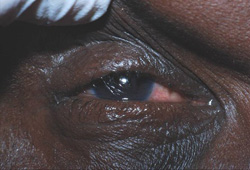Summary
Definition
History and exam
Key diagnostic factors
- presença de fatores de risco
- habitação ou emigração de uma área endêmica
- Características demográficas de risco
- inflamação conjuntival subtarsal
- folículos subtarsais
- cicatrização conjuntival subtarsal
- triquíase
- opacificação corneana e perda da visão
- Fossetas de Herbert
Other diagnostic factors
- assintomático
- secreção ocular e nasal
- olho vermelho
- olho lacrimejante e dolorido
- folículos límbicos
- pannus
Risk factors
- crianças (1 a 9 anos de idade)
- higiene facial insatisfatória
- sexo feminino
- pobreza
- higiene insatisfatória na comunidade
- aglomeração domiciliar
- habitação ou emigração de uma área endêmica
- moscas que procuram os olhos
Diagnostic tests
1st tests to order
- diagnóstico clínico
Tests to consider
- reação em cadeia da polimerase (swab conjuntival)
Emerging tests
- novos testes moleculares e sorológicos
Treatment algorithm
Área endêmica com poucos recursos: com base na prevalência de tracoma ativo
área não endêmica rica em recursos: indivíduo infectado e contato com familiares
área endêmica com poucos recursos: triquíase tracomatosa
área não endêmica rica em recursos: triquíase tracomatosa
Contributors
Authors
Van Charles Lansingh, MD, PhD, MBA
Associate Professor of Ophthalmology
Moran Eye Center
University of Utah
UT
Voluntary Associate Professor
Public Health Sciences
Miller School of Medicine
University of Miami
FL
Help Me See Chief Medical Officer
Director of Research
IMO (Mexican Institute of Ophthalmology)
Santiago de Queretaro
Mexico
Disclosures
VCL declares that he has no competing interests.
Kelly Callahan, MPH
Director
Trachoma Control Program
The Carter Center
Atlanta
GA
Disclosures
KC declares that she has no competing interests.
Acknowledgements
Dr Van Charles Lansingh and Ms Kelly Callahan wish to gratefully acknowledge Dr Paul Emerson, Dr Heathcote R. Wright and Dr Hugh R. Taylor, previous contributors to this topic.
Disclosures
PE declares no competing interests. HRW and HRT are authors of a number of references cited in the topic.
Peer reviewers
Matthew Burton, BChir
Lecturer
International Centre for Eye Health
London School of Hygiene and Tropical Medicine
London
UK
Disclosures
MB declares that he has no competing interests.
Victor Perez, MD
Assistant Professor
Miller School of Medicine
Bascom Palmer Eye Institute
University of Miami
Miami
FL
Disclosures
VP declares that he has no competing interests.
Peer reviewer acknowledgements
BMJ Best Practice topics are updated on a rolling basis in line with developments in evidence and guidance. The peer reviewers listed here have reviewed the content at least once during the history of the topic.
Disclosures
Peer reviewer affiliations and disclosures pertain to the time of the review.
References
Key articles
World Health Organization. Trachoma control: a guide for programme managers. Jul 2006 [internet publication].Full text
World Health Organization. Report of the 4th global scientific meeting on trachoma, Geneva, 27-29 November 2018. Jun 2019 [Internet publication].Full text
Evans JR, Solomon AW, Kumar R, et al. Antibiotics for trachoma. Cochrane Database Syst Rev. 2019 Sep 26;9:CD001860.Full text Abstract
Ejere HO, Alhassan MB, Rabiu M. Face washing promotion for preventing active trachoma. Cochrane Database Syst Rev. 2015 Feb 20;(2):CD003659.Full text Abstract
Burton M, Habtamu E, Ho D, et al. Interventions for trachoma trichiasis. Cochrane Database Syst Rev. 2015 Nov 13;(11):CD004008.Full text Abstract
Reference articles
A full list of sources referenced in this topic is available to users with access to all of BMJ Best Practice.

Differentials
- Conjuntivite de inclusão por clamídia
- Conjuntivite viral
- Conjuntivite bacteriana
More DifferentialsGuidelines
- National guide to a preventive health assessment for Aboriginal and Torres Strait Islander people, third edition
- Trachoma control: a guide for programme managers
More GuidelinesLog in or subscribe to access all of BMJ Best Practice
Use of this content is subject to our disclaimer